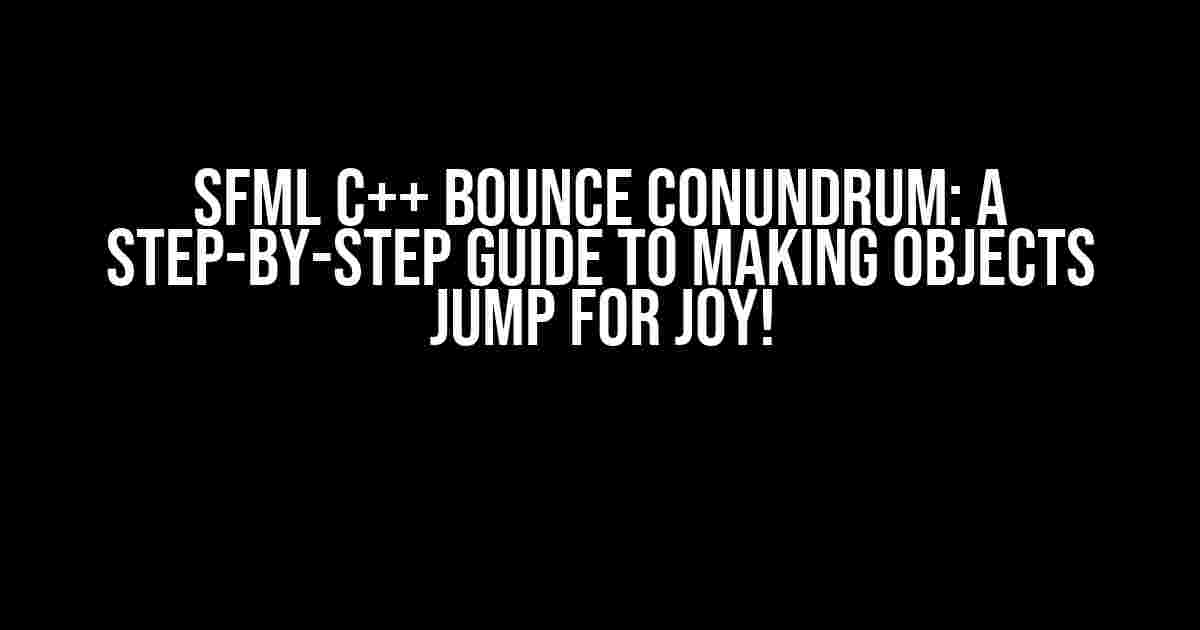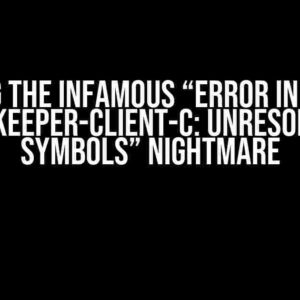Are you tired of watching your SFML objects languish in a state of inertia, lacking the bouncy flair you so desire? Fear not, dear programmer, for we’re about to embark on a thrilling adventure to tackle the perennial problem of making objects bounce in SFML with C++. Buckle up, and let’s dive into the world of physics, vectors, and, of course, bouncy Fun!
Understanding the Basics: SFML and C++
Before we dive into the juicy stuff, let’s quickly recap the essentials. SFML (Simple and Fast Multimedia Library) is a C++ library designed for creating games, multimedia applications, and, in our case, bouncing objects. C++ is the programming language of choice, providing the necessary tools to wield SFML’s power.
To get started, ensure you have SFML installed and set up properly in your C++ environment. If you’re new to SFML, start with their official tutorials to get familiar with the basics.
The Bouncing Conundrum: What’s Going Wrong?
When attempting to make an object bounce in SFML, you might find yourself stuck in an infinite loop of confusion. The object either:
- Remains stationary, defying the laws of physics and your best efforts.
- Bounces erratically, as if possessed by a mischievous spirit.
- Disappears into thin air, leaving you scratching your head.
Don’t worry; we’ll address these issues and more in the following sections. For now, take a deep breath, and let’s begin our investigation into the world of bouncing objects!
Understanding Vectors and Movement
In SFML, objects move using vectors, which are mathematical representations of direction and magnitude (length). Think of a vector as an arrow in space, pointing from the object’s current position to its desired position. To make an object bounce, we need to manipulate these vectors.
sf::Vector2f velocity; // our hero's velocity vector
sf::Vector2f position; // our hero's current position
velocity = sf::Vector2f(5, 5); // set initial velocity (5 units/sec, 5 units/sec)
position += velocity; // move the object by velocity
Implementing Collision Detection
Collision detection is crucial for bouncing objects. We need to identify when our object hits a boundary (e.g., the edge of the screen) and respond accordingly. SFML provides a built-in function for collision detection: sf::FloatRect::intersects().
sf::FloatRect objectBounds = object.getGlobalBounds(); // get object's bounds
sf::FloatRect screenBounds = sf::FloatRect(0, 0, 800, 600); // set screen bounds (800x600)
if (objectBounds.intersects(screenBounds)) {
// collision detected! respond accordingly
}
The Magic of Reflection: Making Objects Bounce
Now that we have the basics covered, it’s time to implement the bouncing mechanism. When an object collides with a boundary, we need to reflect its velocity vector. This is achieved by negating the component of the velocity vector perpendicular to the boundary.
sf::Vector2f normal; // normal vector of the boundary (e.g., screen edge)
sf::Vector2f velocity; // object's velocity vector
// calculate reflection vector
sf::Vector2f reflection = velocity - 2 * (velocity.dot(normal) / normal.dot(normal)) * normal;
velocity = reflection; // update object's velocity
Putting it All Together: A Complete Example
Let’s create a simple program that demonstrates object bouncing in SFML. We’ll create a ball that bounces around the screen when it hits the edges.
#include <SFML/Graphics.hpp>
int main() {
sf::RenderWindow window(sf::VideoMode(800, 600), "SFML Bouncing Ball");
sf::CircleShape ball(20); // create a ball (20px radius)
ball.setPosition(100, 100); // set initial position
sf::Vector2f velocity(5, 5); // set initial velocity
while (window.isOpen()) {
sf::Event event;
while (window.pollEvent(event)) {
if (event.type == sf::Event::Closed) {
window.close();
}
}
sf::FloatRect ballBounds = ball.getGlobalBounds(); // get ball's bounds
sf::FloatRect screenBounds = sf::FloatRect(0, 0, 800, 600); // set screen bounds
if (ballBounds.intersects(screenBounds)) {
// collision detected!
sf::Vector2f normal; // normal vector of the boundary
if (ballBounds.left <= 0 || ballBounds.left + ballBounds.width >= 800) {
normal = sf::Vector2f(-1, 0); // left or right edge
} else {
normal = sf::Vector2f(0, -1); // top or bottom edge
}
sf::Vector2f reflection = velocity - 2 * (velocity.dot(normal) / normal.dot(normal)) * normal;
velocity = reflection;
}
ball.move(velocity); // move the ball
window.clear();
window.draw(ball);
window.display();
}
return 0;
}
Run this code, and you’ll see a ball bouncing around the screen, beautifully demonstrating the power of vectors and collision detection!
Common Pitfalls and Troubleshooting
Even with the provided example, you might still encounter issues. Here are some common pitfalls and troubleshooting tips:
| Pitfall | Troubleshooting Tip |
|---|---|
| Object not bouncing at all | Check your collision detection implementation and ensure the object’s bounds are correct. |
| Object bouncing erratically | Verify your reflection vector calculation and normal vector assignment. |
| Object disappearing | Ensure your object’s position and velocity are updated correctly, and the object’s bounds are within the screen. |
Conclusion: Bouncing into the Future!
With this comprehensive guide, you should now be well-equipped to create bouncing objects in SFML with C++. Remember to carefully consider your vector calculations, collision detection, and reflection implementations. Practice makes perfect, so don’t be afraid to experiment and try new things!
As you continue on your SFML journey, you’ll encounter more challenges and opportunities to learn. Keep in mind the fundamentals covered in this article, and you’ll be well-prepared to tackle even the most complex physics-based projects.
Happy coding, and may your objects bounce with joy!
Frequently Asked Question
Hey there, game devs! Having trouble making objects bounce in SFML? We’ve got you covered! Check out these FAQs to get your objects bouncing in no time!
Q1: Why isn’t my object bouncing at all?
A1: Make sure you’ve set up the collision detection correctly! Check if your object is properly colliding with the boundaries or other objects. If not, revisit your collision detection code and ensure it’s working as expected.
Q2: My object is bouncing, but it’s not bouncing correctly. What’s going on?
A2: This might be due to incorrect velocity adjustments during collision. Double-check your velocity calculations and adjustments when the object collides with something. Ensure you’re correctly inverting the velocity and adjusting the magnitude accordingly.
Q3: My object is bouncing, but it’s getting stuck or stuttering. What’s the deal?
A3: This could be due to over- or under-correcting the object’s position during collision. Try tweaking your collision response code to ensure the object is properly repositioned and its velocity is adjusted smoothly.
Q4: How do I make my object bounce more realistically?
A4: To create more realistic bounces, try introducing some damping or energy loss after each collision. This will make the object slow down and lose energy over time, creating a more natural bouncing effect.
Q5: Can I use predefined physics engines or libraries for bouncing objects?
A5: Absolutely! SFML has built-in support for physics engines like Box2D, which can handle complex collisions and bounces for you. Look into integrating a physics engine into your project to take the hassle out of manual collision detection and response.


